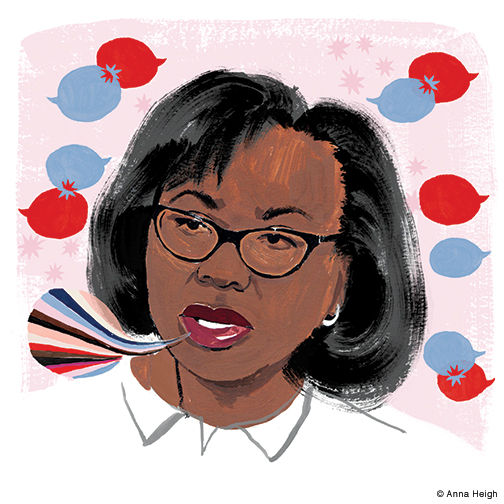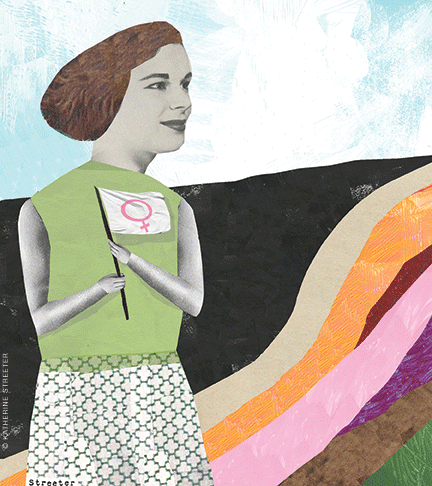When the University created a women’s studies program in the early 1970s, one prominent Penn professor described the field as “a fad that, without question, would disappear soon,” according to Demie Kurz, a sociology professor and the program’s co-director. “Happily, he could not have been more wrong.”
Since its inception in 1973, the program has flourished, and now offers a major, a minor, a graduate certificate, fellowships, endowed lectures, and more than 50 courses with 1,300 enrollments each year.
The program celebrated its 35th anniversary—and affirmed that it is far from a fleeting fad—with an all-day academic conference in October. More than two dozen Penn professors presented on topics as varied as the program’s courses.
“A lot has happened since our 25th-anniversary conference,” said program director Rita Barnard, an English professor [“Making Waves,” Jan|Feb 1999]. The field “isn’t just feminist theory anymore,” she added, observing that the program has “tried to embrace the emergence of gender and sexuality studies” as well.
One of 12 morning presentations featured Heather Love, an associate professor of English who often teaches these newer gender- and sexuality-themed courses. “Whatever happened to the spinster?” Love asked. “Have we moved beyond the spinster stereotype, or have we simply forgotten her?” While the spinster was a vital figure in first- and second-wave feminism, Love posited, the third wave has “tended to leave her behind … I want to argue that the rise of the lesbian runs parallel with the fall of the spinster.”
Love discussed 19th-century author Sarah Orne Jewett’s cultivation of the “spinster aesthetic” in both her writing and personal life. Jewett never married, and some modern scholars have speculated that her relationship with the writer Annie Fields was more than platonic. “There is an ineradicable loneliness in the figure of the spinster,” Love concluded. “Rather than trying to cure that loneliness, we need to incorporate it into the genealogy of queerness.”
In a lunchtime session on “Gender, Inequality, and Education,” several professors examined the status of women as students and teachers. Peter Kuriloff, a Graduate School of Education professor and expert on gender dynamics and education, discussed his research on how prep schools create a male-centric environment through “an underlying curriculum that fosters a hard-edged, hegemonic masculinity, often at the expense of women, girls, and many boys.”
Sociology professor Jerry Jacobs then presented data on what happens next: “the enormous discrepancy [in higher education] between women as students and women as faculty.” According to his statistics, women surpassed men in earning bachelor’s degrees in the 1980s, and during the last decade have obtained about 57 percent of the BA degrees awarded. (As of 2007, women were also earning more master’s and associates degrees than men, he said.)
Yet “some trends are harder to fix, and gender differences persist,” Jacobs said. He noted that nationally, women hold just 25 percent of full professorships and less than half of the country’s associate and assistant professorships. Sociology professor Janice Madden, who served as the session’s moderator, later pointed out that this may partly be due to women hopping on the tenure track between ages 30 to 40, “right during their child-bearing years.”
Nevertheless, Jacobs observed that women still rate their own academic ability, math ability, competitiveness, emotional health, and physical health far lower than men do. “Things are complicated,” he added.
The conference ended with a look back at the program’s origins, presented by Phyllis Rackin, an emeritus English professor who came to Penn in 1962.
“Without strong student initiative, I doubt that we would have had our women’s studies program,” Rackin noted. In fact, she went on, it was a student sit-in—spurred by a series of campus rapes—that prompted administrators in the early 1970s to promise “much-needed improvements to women’s safety, the establishment of a women’s center, and support for a women’s studies program.
“We’ve come a long way since then,” she added, “[and] some of us might be tempted into complacency … But here again our wonderful feminist students have something to teach us.” She cited a new student literary journal, The F-Word: A Collection of Feminist Voices. “For these feminist students at Penn, what we have is very far from being all we need or all we deserve. Once again, I think the students are right.”
— Molly Petrilla C’06




